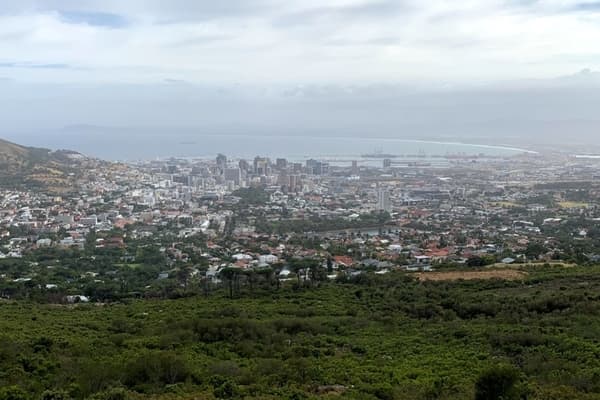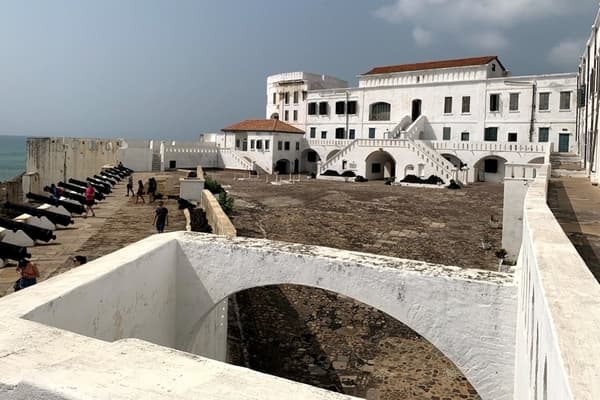Africa Trek: An eye-opening experience and first-hand look at market trends

The Cornell MBA group on the Black Star Square in Accra, Ghana
Last December, I seized the opportunity to take part in an international trek with the support of Cornell University. The trek brought me to South Africa and Ghana, two African countries I truly wanted to discover. Having previous work experience in Tunisia, North Africa, I was eager to expand my knowledge and hone my comparative outlook of the continent’s different regions.
South Africa: A thriving Rainbow Nation
With a 20-student group, we kicked off with three days in Johannesburg, the economic capital of South Africa and a former mining city. During the gold rush of the nineteenth and twentieth centuries, Johannesburg was the destination hub of the entire African continent, with migrants flooding in from all over the world. The city, fondly referred to as Joberg by South Africans, recalled Detroit for me—a former powerhouse that faced deindustrialization in the recent past and that is now on the verge of a revival thanks to a sprawling new ecosystem of young entrepreneurs, chefs, and artists. While visiting Joburg, we would also come to know Soweto (South West Township), where Black South Africans lived during apartheid.
Among the excursions in Johannesburg, we visited the Apartheid Museum which shed light on the history of South Africa: before, during, and after apartheid—including the different conflicts that took place among the Afrikaners (Boers) and the English. In 1948, apartheid was implemented as a result of only a slight electoral margin. The museum presents the different struggles in the country and beyond, including the economic sanctions South Africa would come to face until South African President Frederik Willem De Klerk negotiated with Anti-Apartheid Leader Nelson Mandela and the African National Congress to end this infamous system in 1991.
At the museum, we learned about the key role of Archbishop Desmond Tutu in building the rainbow nation thanks to the Truth and Reconciliation Commission, which revealed the wrong-doings of the government during apartheid. Today, the South African flag is composed of six colors, all of which bear different meanings: red for the conflicts during Apartheid, blue for the African sky, green for the fertility of the land, black and white for the color of its people, and gold for the abundant natural resources.

In Joburg, we also met with an MBA Cornell alumnus, now the development director for Yum! Brands (Pizza Hut, Burger King) in Africa. He shared his vision of African development. Learning about the not so obvious discrepancies across the continent was enriching. We then headed to the famous city of Cape Town, which shows European architectural and planning influences with its smaller buildings and districts. At the same time, it is surrounded by the beauty of nature; the ocean and the mountains, including the incredible Table Mountain, are right on its doorstep. Here, we visited a state-owned vineyard that produces and exports state-of-the-art wines and traditional brandies.
Ghana: A rising gross national product and soaring tourism
After visiting Cape Town, we left South Africa to fly to Accra, the capital of Ghana in Western Africa. The location of Ghana is noteworthy, as all neighboring countries (Ivory Coast, Burkina Faso, and Togo) are francophone. Ghana, a former British colony, acquired its independence in 1957 under the influence of Kwame Nkrumah, who became the first president of Ghana and one of the main leaders of pan Africanism. The country of 29 million Ghanaians is composed of 75 different ethnic groups.
We learned that the economy of Ghana relies mainly on natural resources: gold, cacao, oil, and manganese. It is worth noting that Ghana is now the world’s largest exporter of gold ahead of South Africa, and both Ghana and Ivory Coast produce 75 percent of the world’s production of cacao. Ghana is also exploring tourism as a new source of income. In 2019, tourism soared due to “the year of return”—the 400-year anniversary of the first slaves being forcibly exiled from the country. Thus, many cultural activities are organized in honor of this anniversary and Ghanaian culture.
While in Ghana, we visited different fortresses built by the former colonial powers: the Dutch, the Portuguese, and the British. These fortresses are all World Heritage Sites and are sadly known for their use during slavery. They were arranged in similar forms with dungeons for captured slaves, who could wait as much as three months to be taken to sea. The detention conditions were not only cruel and horrifying but atrocious. Once a vessel arrived from Europe, slaves were chained to one another and walked through the “door of no return” where they were shipped to the Caribbean, North America, or South America to work in the plantations. Such operations remained until 1833 in the Cape Coast fortress. According to some estimations, slavery impacted 60 million people in Africa, of whom only 12 million survived.

We also met with local entrepreneurs in Ghana, who shared their vision and optimism about the future of the country. In recent years, the gross domestic product has doubled and is now around USD 65 billion. One of the entrepreneurs worked on developing a local school with international standards, providing entrepreneurship and new technology courses. She stressed that in countries like Ghana “everything is yet to be created and developed,” opening a broader perspective for the first generation of entrepreneurs.
I am very grateful to the Emerging Markets Institute of the Samuel Curtis Johnson Graduate School of Management for sponsoring this eye-opening experience. Not only was I given better exposure to the different market trends in Africa but also a better understanding of the culture of the countries we visited. This lifetime experience comforts me in thinking about leadership based on humility, hard work, and open-mindedness.

